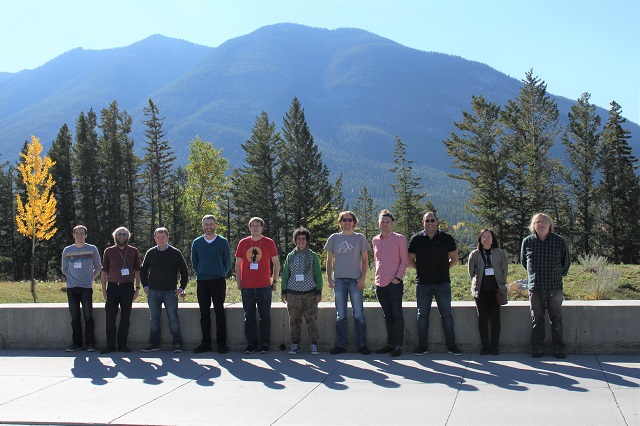Defects and Distortions of Layered Complex Fluids (22w5159)
Organizers
Scott MacLachlan (Memorial University of Newfoundland)
Timothy Atherton (Tufts University)
Patrick Farrell (University of Oxford)
Emmanuelle Lacaze (Sorbonne Université)
Francesca Serra (University of Southern Denmark)
Description
The Banff International Research Station will host the "Defects and Distortions of Layered Complex Fluids" workshop in Banff from October 02 to October 07, 2022.
Complex fluids that incorporate periodic layered order, such as smectic liquid crystals, block copolymers, membranes, and vesicles, possess remarkable properties because of the geometric and topological consequences of layering: external influences, such as boundary conditions and applied fields, may force deformations of the fluid that are incompatible with the layering, leading to geometric frustration and the spontaneous assembly of a wide variety of textures with characteristic defect structures.
There has been a recent explosion of interest in exploiting the ability of smectics, as a paradigmatic example of a layered fluid, to repeatedly self-assemble over device length-scales. Applications have been driven by advances in surface control, leveraging surface patterning, topographical features such as grooves or posts, confinement in droplets or upon curved surfaces to produce emergent patterns that are optically active as lenses, gratings, photonic crystals or lithographic templates. Moreover, defect structures in the texture can be used to efficiently trap dispersed nanoparticles, making these materials useful for hierarchical or synergistic assembly processes that could potentially be adopted for metamaterial, sensor or solar cell production.
Despite the remarkable experimental interest, the very complicated structures that emerge in these systems have proven to be extremely challenging to model computationally. While many observed phenomena have been understood through elegant geometric approaches or by perturbing from a less-ordered phase, to date there have been few successful efforts to use computation to predict the structures adopted by smectics in general configurations. Such methods could be of great benefit to structure prediction, particularly in scenarios where partial smectic order exists, such as during phase transitions, or to understand dynamical phenomena such as the shape evolution of films and bubbles.
The primary objective of this workshop is, therefore, to bring together bring together computational physicists, applied mathematicians and experimentalists together to identify: Geometries and experimental phenomena of interest that have become amenable to simulation; New theoretical questions about the structure and self-assembly of layered media that could be investigated computationally; New experiments that may now be possible due to emerging computational modelling approaches; Opportunities to formulate simulation methods for other layered media beyond smectics; New mathematical approaches that might further accelerate research on the broad category of layered fluids; How to exploit the interplay of geometry, topology and computation for improved algorithms.
The Banff International Research Station for Mathematical Innovation and Discovery (BIRS) is a collaborative Canada-US-Mexico venture that provides an environment for creative interaction as well as the exchange of ideas, knowledge, and methods within the Mathematical Sciences, with related disciplines and with industry. The research station is located at The Banff Centre in Alberta and is supported by Canada's Natural Science and Engineering Research Council (NSERC), the U.S. National Science Foundation (NSF), Alberta's Advanced Education and Technology, and Mexico's Consejo Nacional de Ciencia y Tecnología (CONACYT).






